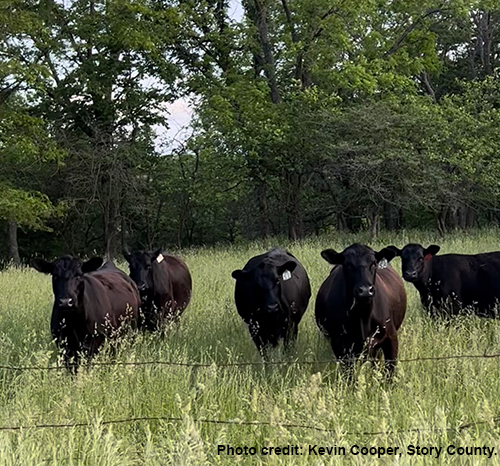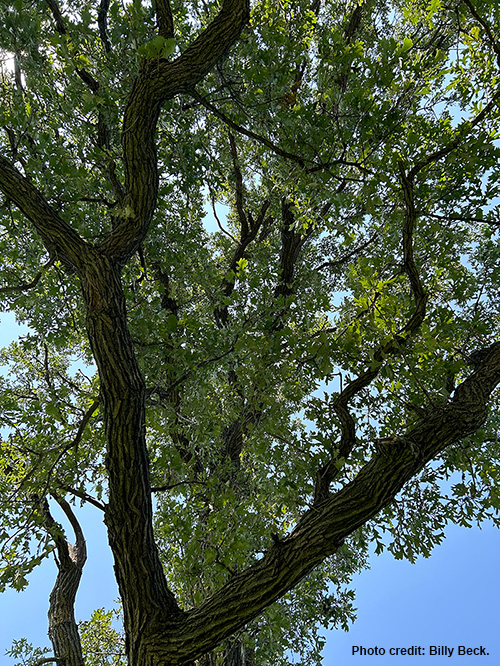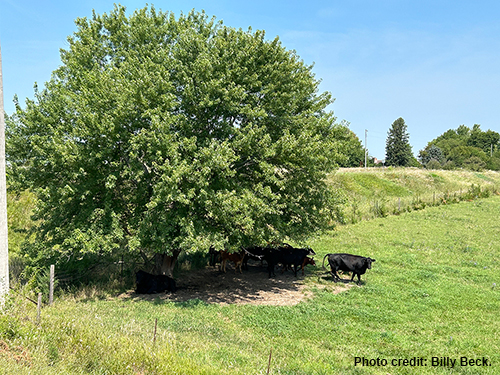Growing Beef Newsletter
August 2024, Volume 15, Issue 2
Pasture Trees for Shade: Top Considerations for Establishment, Management, Resilience
Billy Beck, ISU extension forestry specialist
Trees Benefit Livestock, Graziers, and Iowa’s Agroecosystem
My experiences observing grazing operations in the sun-drenched states of Kansas and Florida are constant reminders that a.) the sun impacts livestock in numerous ways, and b.) trees are critical infrastructural components of grazing systems. The strategic combination of trees, forage and grazing livestock is often referred to as silvopasture. In addition to providing livestock with thermal, solar, and weather protection during all seasons, silvicultural practices (e.g., incorporation of trees within pastures) may improve forage quality, augment livestock diets via mast provision (e.g., acorns), and help graziers diversify their economic portfolio through harvest of timber, fuelwood, and non-timber products. Tree-associated ecosystem goods and services abound as well, and include enhanced water quality, nutrient cycling, wildlife habitat, and aesthetics. Effective establishment and management of trees in pasture systems requires some “outside of the forest” thinking, however. Below, I present top points to consider regarding pasture trees and shade, in terms of species selection, spacing, and resilience.
Species Selection
Three top tenets of tree planting are 1.) match the species to your site and soils, 2.) strive to establish native species when possible and, 3.), establish a diversity of trees within the planting. When used together, the USDA Web Soil Survey, and the Iowa Woodland Suitability Recommendations will provide a list of tree and shrub species that will work on specific sites. From these lists, identify species that possess an open crown form – a form that provides the adequate mix of sun for forage and shade for livestock (Photo 2), wind-resistant characteristics (e.g., stout branches), thicker mature bark, and moderate growth rate. Consider economic and ecosystem goods and services benefits too, such as fuel wood and wildlife and pollinator benefits. Lastly, and perhaps most important, is to eliminate from contention species that exhibit toxicity to the livestock of interest. Explore the range of forms, growth rates, mature height and spread, and canopy characteristics of Iowa tree species within the Forestry Encyclopedia Articles present within the overall ISU Natural Resource Stewardship website.
Spacing and Canopy Management
When planning tree spacing and arrangement (e.g., row versus grid), there is no cookbook recipe for success. During initial planning stages, it’s important to consider 1.) desired degree of protection for the livestock in question (e.g., canopy density), 2.) sunlight needs of the forage in question, 3.) growing space requirements of individual tree species, and 4.) potential thinning schedule, based on items 1-3 and the selected species. In general, however, mature trees per acre in grazing systems often range from 50 (30’x30’ spacing) to 200 (15’x15’ spacing). Exceptionally sparse plantings may result in livestock concentration around individual trees (Photo 3), which may compact soils, damage fine roots, and heighten erosion risk. Wide spacings will produce greater lateral crown spread with reduced height growth, which may be desirable in pastures. If fuelwood or timber products are desired, tighter spacings and shorter thinning intervals would be need to be considered. Lastly – think maintenance. Herbicide application, thinning, and mowing practices will require equipment access, so plan tree spacing accordingly. Because of the multitude of factors that will inform spacing and arrangement decisions, consultation with a professional forester is an invaluable step in this process. Locate the professional foresters that serve your county using our Forestry Contacts web tool.
Resilience
Resilient trees are much less vulnerable to stressors such as pests and pathogens, herbivory, and wind damage. Resilience starts with vigorous trees, and vigorous trees rely on proper site preparation and planting, control of competing vegetation, protection from physical damage (including root damage from soil compaction), and appropriate thinning to ensure maximum sunlight capture by individual canopies. In addition to promoting individual tree vigor, establishing a diversity of species and age classes within pastures is essential. Primer-level tutorials on the aforementioned activities are provided within the newly-released Iowa Woodland Steward Toolkit Series – a 31-video YouTube series tailored for Iowa woodland owners and producers. Detailed information on chemical control for unwanted vegetation may be viewed here. As with species selection and spacing decisions, professional foresters are key resources for producers when designing a pasture tree maintenance plan.

Photo 1: Pasture trees benefit not only livestock, but graziers, wildlife, water quality, and Iowa’s
overall agroecosystem. Photo credit: Kevin Cooper, Story County.

Photo 2: Moderately-dense canopies of species such as bur oak offer an effective mix of shade
and sun. Author photo.

Photo 3: Low numbers of trees per acre lead to livestock concentration, which may compact
soils, enhance erosion risk, and harm fine roots. Author photo.
This monthly newsletter is free and provides timely information on topics that matter most to Iowa beef producers. You’re welcome to use information and articles from the newsletter - simply credit Iowa Beef Center.
Archived issues
